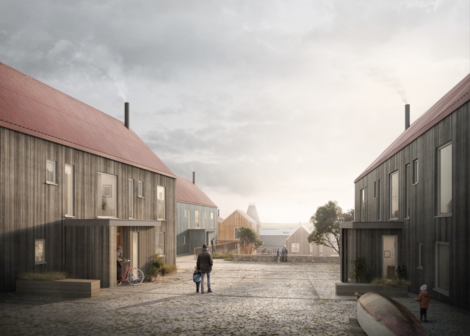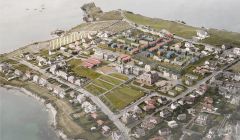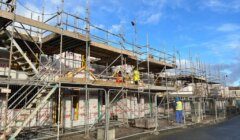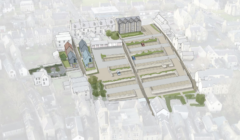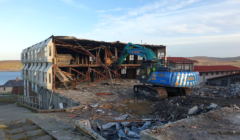Housing / Proposed reduction in government funding set to affect housing project timelines
SHETLAND Islands Council (SIC) has been advised to plan housing developments over the next five years against a backdrop of reduced government funding – leading to indicative timelines for some projects being pushed back.
The first housing phase of the SIC’s Knab redevelopment in Lerwick could now only begin in 2027/28, although a revamp of the existing Janet Courtney hostel building should get underway before that.
The SIC’s housing manager Anita Jamieson told elected members her advice is to focus on year one of its refreshed housing plan – 2025/26.
She noted that, for example, a Scottish Parliament election is coming in 2026.
The SIC produces a strategic housing investment plan (SHIP) based on indicative government funding for the next five years, and it is refreshed annually.
Jamieson told a meeting of the SIC’s development committee on Wednesday the latest update has been “challenging”, due to the Scottish Government advising local authorities its affordable housing funding budget is to decline further.
The current SHIP is £16 million down in total over the next five years compared to the 2024/25 programme.
Jamieson said the indicative funding is the “minimum planning assumption” and is not specifically the money for the SHIP.
The updated plan looks to deliver 160 units of accommodation across Shetland over the next five years, which is less than previously expected.
This includes early phases of the SIC’s Knab redevelopment, as well as Hjaltland Housing Association’s Staney Hill project.
In order to achieve compliance with the funding assumptions, and to allow a 25 per cent slippage factor, the Knab project has been prioritised to focus initially on turning the Janet Courtney Hostel into flats.
The total project cost for the Janet Courtney is nearly £5.6 million, and work could commence on site in January 2026.
Become a member of Shetland News
Construction on the first phase of housing for the Knab redevelopment is now being planned for 2027/28.
The SHIP said the phases of Staney Hill are also being re-profiled, which will extend the programme of works and expected completion.
The redevelopment of the former Eric Gray Centre site in Lerwick has been prioritised for 2026/27, while the cost of most refurbishment projects will now have to be met from from the SIC’s housing revenue account.
Under the SHIP, “off the shelf acquisitions” have also been reduced from a maximum of four per year to just one.
Plans for housing at the former Moorfield Hotel site in Brae have been removed from the SHIP for now.
However, this is a Hjaltland project and it could be brought forward if funding becomes available.
Speaking at Wednesday’s meeting Jamieson said the focus for the council should be on 2025/26.
There was suggestion that the next Scottish parliament election, in May 2026, could potentially change the funding picture, while the budget relationship with the new UK Labour government remains unclear.
The SNP are currently in power at Holyrood but Labour is expected to have increased momentum following the party’s rise to government at Westminster earlier this year.
Other challenges include contractor capacity and development costs “which continue to be very high”, Jamieson said.
She added things are in an “interesting place” where the Scottish Government has a housing strategy through to 2040, and housing emergencies have been declared, but there is “budget uncertainty” and pressure on supply.
Jamieson added the council has been “quite good” at picking up other slippage across the wider region when it comes to government housing funding – suggesting the money coming to the SIC could increase in the future if this plays out.
In debate SIC leader Emma Macdonald said housing is important for health and wellbeing – and if the Scottish Government wants to decrease pressure on NHS then “investing in housing should be seen as a priority”.
Lerwick North and Bressay councillor Stephen Leask added he hoped the Scottish Government would use some of the extra £3.4 billion pledged to Scotland from the UK Labour government for 2025/26 to put towards housing.
He added the SNP should get their priorities right rather than look to their “usual vanity projects”.
Lerwick member Cecil Smith also questioned if the SIC could plug the gap itself when it comes to £2 million the council is now anticipated to miss out on in 2025/26.
Meanwhile development committee chairman Dennis Leask said it “doesn’t add up” that the Scottish Government has declared a national housing emergency but is advising budgets will be reduced.
He also warned that it could send out a negative message to the local construction industry.
Shetland West councillor Liz Peterson also spoke up for more housing in rural areas and suggested there would be benefit in smaller contractors taking on jobs involving two or three housing units, for example.
The latest SHIP also highlights how recent and newly emerging legislative changes which impact on design – such as in energy efficiency, fire suppression and building standards – are estimated to add between £40,000 and £50,000 per unit to build costs.
“With already high unit costs being experienced there is a threat to affordability of increasing legislative demands,” it adds.
“Further changes mainly around energy efficiency and net zero are yet to be fully enacted but will have further cost implications.”
At Wednesday’s meeting councillors approved the 2025-30 SHIP and also noted that a review of the use of the second homes council tax fund will take place during 2025/26.
Become a member of Shetland News
Shetland News is asking its many readers to consider paying for membership to get additional features and services: -
- Remove non-local ads;
- Bookmark posts to read later;
- Exclusive curated weekly newsletter;
- Hide membership messages;
- Comments open for discussion.
If you appreciate what we do and feel strongly about impartial local journalism, then please become a member of Shetland News by either making a single payment, or setting up a monthly, quarterly or yearly subscription.
















